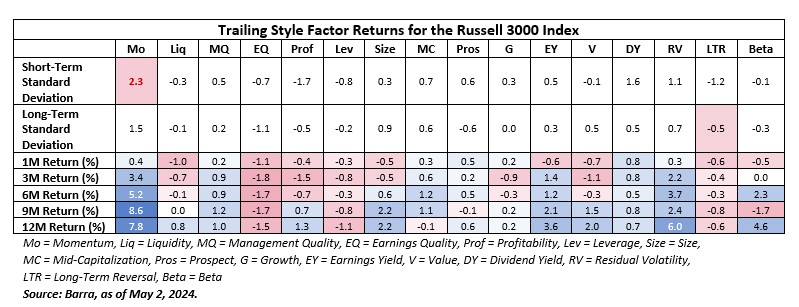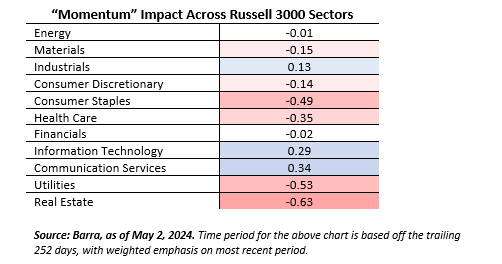KEY POINTS
1. Over the short term (nine months), the momentum factor is at a level occurring only 3% of the time since 1995, when factors began being measured.
2. We believe it's important to focus on why the dominance of momentum factors impacting performance is at a high.
3. We believe a broadening of the market, which has slowly begun over the last few months, is very likely to continue.
As anyone watching U.S. equity markets is aware, the winners have kept on winning, leading to the current narrowness. However, the relevance and impact of this historically unprecedented momentum, and its resultant effects on portfolio performance, may surprise even savvy market watchers.
In late 2022, we wrote a blog titled "Looking Under the Hood: Not all Equity Returns Are Equal," explaining the importance of understanding what is driving portfolio returns in order to eschew unintended risk. We also dug into the various elements that drive tracking error, namely security selection and factor exposure.
Over different times, factors tend to ebb and flow in terms of what is driving and what is stalling portfolio performance. By definition, and as can be seen from the table below, most factors are typically within 1.5 standard deviations or less of their central tendency.

Over the short term (nine months), however, the momentum factor2 is now at a 2.3 standard deviation, which has only happened 3% of the time since 1995, when factors began being measured. Within that number, the sectors primarily driving this momentum run within U.S. equities (as measured by the Russell 3000 Index) have been information technology and communication services.

As we said in the 2022 blog, our strategies are primarily driven by security selection. However, as we review risk reports, along with our typical meaningful contribution from security selection, the dominance of factors coming into play to impact performance is at a high. In our view, this trend is too notable to ignore.
We are consistent bottom-up, value investors, regardless of trends in the market. Our team seeks out leading companies we believe are priced at a discount to their intrinsic value due to being mispriced, out of favor, or misunderstood by the market. These are not the companies that have been driving this momentum in the market. Fortunately, our security selection year-to-date has outdone this strong factor phenomena.
In addition to being consistent value investors, we are also long-term investors. With how stretched the momentum trade currently is, we believe a broadening of the market (which has slowly begun over the last few months) is very likely from here.
Bottom line: We believe consistency is key amid uncertainty, and we continue to follow a proven investment philosophy and process to construct portfolios for clients with an emphasis on stock-by-stock decisions, based on an assessment of risk and reward. A relentless focus on acquiring leading companies when the market offers them at discounts to their intrinsic value is essential to adding value for clients over time, regardless of market trends.
1In capital market theory, momentum factor is a well-known market anomaly in which securities that have risen in recent months tend to continue to rise.
2Ibid.
Forecasts and/or estimates provided herein are subject to change and may not actually come to pass.
Russell 3000® Index measures the performance of 3,000 U.S. large-cap, mid-cap and small-cap stocks and is designed to represent approximately 98% of investable U.S. equities by market capitalization. Unless otherwise stated, index returns do not reflect the effect of any applicable sales charges, commissions, expenses, taxes or leverage, as applicable. It is not possible to invest directly in an index.
Correlation is a statistical measure of how two securities move in relation to each other.
Standard Deviation measures how widely individual performance returns, within a performance series, are dispersed from the average or mean value.
Past performance is not a guarantee of future results.
Featured Insights
Risk considerations: The value of investments may increase or decrease in response to economic, and financial events (whether real, expected or perceived) in the U.S. and global markets. The value of equity securities is sensitive to stock market volatility. Diversification does not eliminate the risk of loss. Active management attempts to outperform a passive benchmark through proactive security selection and assumes considerable risk should managers incorrectly anticipate changing conditions.
The views and opinions and/or analysis expressed are those of the author or the investment team as of the date of preparation of this material and are subject to change at any time without notice due to market or economic conditions and may not necessarily come to pass. Furthermore, the views will not be updated or otherwise revised to reflect information that subsequently becomes available or circumstances existing, or changes occurring, after the date of publication. The views expressed do not reflect the opinions of all investment personnel at Morgan Stanley Investment Management (MSIM) and its subsidiaries and affiliates (collectively “the Firm”), and may not be reflected in all the strategies and products that the Firm offers.
Forecasts and/or estimates provided herein are subject to change and may not actually come to pass. Information regarding expected market returns and market outlooks is based on the research, analysis and opinions of the authors or the investment team. These conclusions are speculative in nature, may not come to pass and are not intended to predict the future performance of any specific strategy or product the Firm offers. Future results may differ significantly depending on factors such as changes in securities or financial markets or general economic conditions.
This material has been prepared on the basis of publicly available information, internally developed data and other third-party sources believed to be reliable. However, no assurances are provided regarding the reliability of such information and the Firm has not sought to independently verify information taken from public and third-party sources.
This material is a general communication, which is not impartial and all information provided has been prepared solely for informational and educational purposes and does not constitute an offer or a recommendation to buy or sell any particular security or to adopt any specific investment strategy. The information herein has not been based on a consideration of any individual investor circumstances and is not investment advice, nor should it be construed in any way as tax, accounting, legal or regulatory advice. To that end, investors should seek independent legal and financial advice, including advice as to tax consequences, before making any investment decision.
Charts and graphs provided herein are for illustrative purposes only. Past performance is no guarantee of future results. The indexes are unmanaged and do not include any expenses, fees or sales charges. It is not possible to invest directly in an index. Any index referred to herein is the intellectual property (including registered trademarks) of the applicable licensor. Any product based on an index is in no way sponsored, endorsed, sold or promoted by the applicable licensor and it shall not have any liability with respect thereto.









